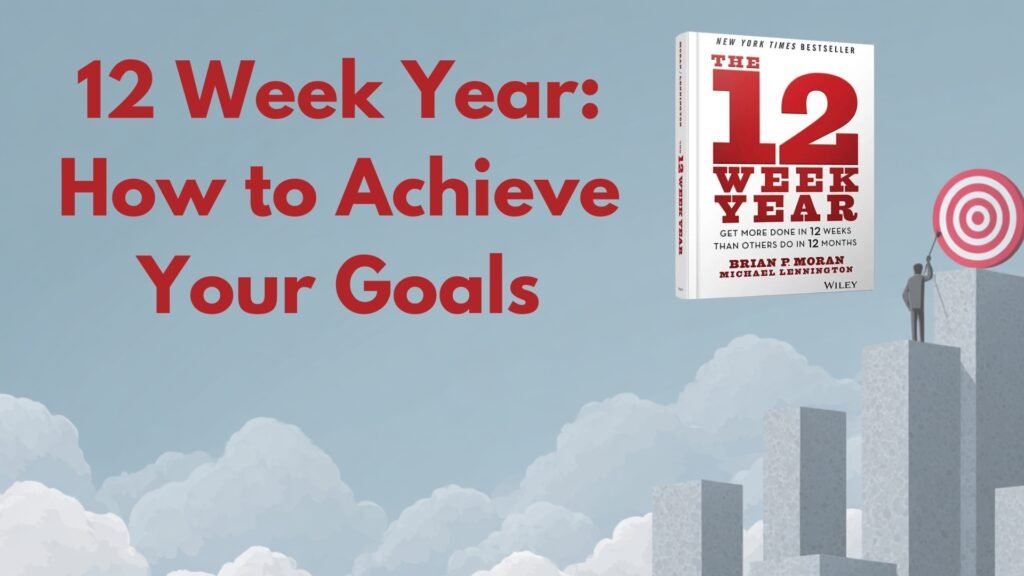
Sept. 27th, 2025


Written by Dan Mintz, a leading productivity strategist, expert in the 12 week year, and the founder of the 12-Week Breakthrough Program. Wharton MBA, MIT Data Scientist, 3x Entrepreneur.
Worked with dozens of people to transform their lives in 12 weeks.
Every January, I bought the perfect planner. I set color-coded goals, created spreadsheets, and swore that this year I’d finally achieve them.
But by February, the energy had faded.
By June, I was “restarting” for the third time.
And by December, I had a pile of plans—but very few real results.
The truth was painful: I was busy but not making progress. I consumed endless productivity books, podcasts, and blogs. I called that progress, but it wasn’t. My annual goals gave me room to procrastinate, and procrastination won every time.
The turning point wasn’t New Year’s Day. It was a random Tuesday in June. I opened my “Game Plan” for the year and asked myself one simple question: What have I actually achieved? The list was shockingly short. I felt embarrassed, frustrated, and even scared—what if I simply didn’t have what it takes to be consistent?
That night, I made a small commitment: instead of planning for a year, I would plan for just twelve weeks. I chose one meaningful goal, blocked time in my calendar, built a scorecard, and reviewed my progress weekly.
Twelve weeks later, I had achieved more than I had in the previous year. I published consistently, launched a small product, and even improved the basics of my daily life.
That’s when I realized: the secret to achieving goals is not motivation—it’s the system you use. And the 12 Week Year provides exactly that system.
The 12 Week Year is a productivity and goal-achievement system created by Brian Moran and Michael Lennington. Instead of spreading goals over 12 months, you treat every 12-week cycle as if it were an entire year.
In practice, that means you:
It’s not a hack. It’s an operating rhythm that transforms goals from vague intentions into achievable milestones.
Most people don’t fail because they’re lazy. They fail because their timeframe sets them up to drift. A year is simply too long.
Here are four reasons why annual planning sabotages goal achievement:
That’s why most resolutions die by February and why only 8–10% of people keep annual goals beyond six months.
Check out this study about how most people fail to achieve their goals.
The 12 Week Year succeeds because it matches how humans actually focus, learn, and stay motivated. It’s rooted in proven psychology:
In short: the 12 Week Year isn’t just effective. It’s humane.
Here’s exactly how to set up your first 12-week cycle.
Your vision is the compass for every decision. Keep it simple and visible.
Write it on one page. Keep it on your desk, lock screen, or notebook cover.
Focus beats volume. One primary goal is best. Add a supporting goal only if it complements the first.
Examples:
Your goals must be realistic within 12 weeks but challenging enough to stretch you.
Translate goals into Most Important Tasks for each week.
Example (publishing goal):
Block time for each MIT in your calendar. If a block gets moved, reschedule it immediately.
Measure what you control, not just results.
Build a simple weekly scorecard. Aim for 85–100% completion. If you drop below 70% for two weeks in a row, reduce your scope.
Every week, take 15–30 minutes to reflect:
Do this alone, with a partner, or with a group. The key is consistency.
At the end of 12 weeks, review your scorecard, reflect on wins and misses, and reset goals for the next cycle.
This is powerful: instead of dragging failures all year, you reset four times annually. Each “new year” is never more than a few weeks away.

The 12 Week Year doesn’t just help you achieve goals. It reshapes how you live.
It changes what you do and how you see yourself.
It’s a system that turns 12 weeks into your “year.” You set short cycles with clear goals, weekly tasks, and real accountability.
Annual plans encourage delay. The 12 Week Year creates urgency, focus, and faster feedback. You don’t wait a year to reflect—you course-correct every week.
Deadlines are close. Weekly reviews make drift visible instantly. With no room to hide, you act now.
Yes. It works for health, fitness, creativity, career, and business. The process is universal.
One primary goal and, at most, one supporting goal. More than that dilutes effort.
Don’t try to “catch up” by cramming. Return to the cadence. Adjust scope if needed. The key is consistency.
No. A one-page vision, a simple calendar, and a scorecard are enough. You can use apps if you prefer, but simplicity keeps it sustainable.
Absolutely. Teams set collective goals, track lead measures, and hold weekly WAMs together. Peer accountability drives performance.
Because annual planning hides procrastination. Twelve-week cycles remove the cushion and force action now.
Beyond productivity, the 12 Week Year builds trust in yourself. You stop negotiating with your goals and start achieving them, one cycle at a time.
Annual planning encourages delay. The 12 Week Year forces execution.
Every 12 weeks becomes a new year—with fresh goals, fresh focus, and fresh momentum. Instead of vague resolutions, you get measurable results.
If you’ve been stuck in “someday,” this system can break the cycle. Don’t wait for another January. Start today. Choose one meaningful goal, commit to 12 weeks, and track your actions.
Freedom and fulfillment aren’t built in 12 months. They’re built 12 weeks at a time.

Dan Mintz is the creator of the 12 Week Breakthrough Program. He advised dozens of individuals on how to achieve their most ambitious goals and reach their full potential.
Dan can be reached at:
dan.mintz@12week-breakthrough.com
About Dan Mintz
Additional Links:
Join the Program
Our Blog Page
https://12week-breakthrough.com/12-week-system-vs-productivity-hacks/
12 Week Year Implementation Guide 2026
Getting Things Done vs the 12 Week Year
Ahcieve Your Most Ambitious Goals with the 12-Week Year
Why 12 Weeks vs 12 Months?